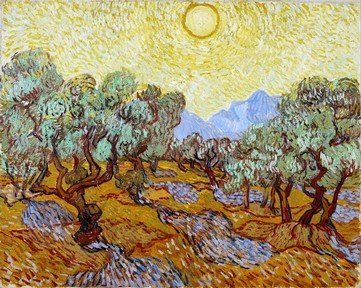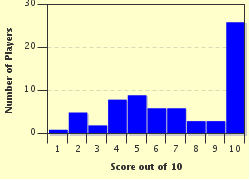Quiz Answer Key and Fun Facts
1. In this painting the infant Christ holds a pomegranate, symbol of rebirth, fertility and abundance. It can also be read as the symbol of the future Passion of the Christ. The Child's and the Virgin's left hands unite upon the pomegranate. Both the Virgin and the Child have a melancholic complexion and the couple is surrounded by angels. The painter is largely indifferent to perspective, anatomical perfection or conventional mythological roles. He is renowned for his allegorical use of ancient mythology facts, combined with philosophical and literary meanings. His depictions of Venus, for example, are partly symbolic, with an infusion of idyllic and pastoral emotions.
Who painted "Madonna of the Pomegranate", c. 1487?
2. This painting is another portrait of the Virgin and Child with a pomegranate. Besides the symbolism of the fruit, the artist introduces scenes from St. Anne's life in the surroundings, as if the melancholic Virgin is protected and brought to her destined life by her past. This painter's works are characterized by lyrical delicacy and exquisite pale lighting, a fact obvious in this painting too, where we can see the purification of the human figure and light color tones with subtle gradations: pinks, ivory whites and transparent greens. The artist painted another well-known Madonna: "Madonna with Child and two Angels", c. 1465.
Who painted "Madonna with the Child and Scenes from the Life of St. Anne", c. 1452?
3. In this painting a delicate Virgin dressed in rich blue cloth holds a robust child who keeps in his hand the top part of a sliced pear. The symbol of the pear is in opposition with the "apple of discord", its sweet taste expresses the sweetness of mouth and heart, which are the gifts of the wise. Known for his paintings, woodcuts and engravings, the artist who painted this Madonna also completed throughout his life a few etchings in iron, bold landscape watercolors, scientific writings and illustrations.
Who painted "Madonna of the Pear" in 1512?
4. This painting is among the first depictions in Western art history of Bacchus in the company of a still-life composed of fruit and a glass of wine, with vine leaves in his hair. A young Bacchus is holding the glass with red wine in his left hand as if he were an image in a mirror. He looks like a human figure, like the models the painter took for his paintings from the real life on the streets. The artist paints the fruit basket and the glass with outstanding realism, paying attention to every detail. He is renowned for the use of selective and dramatic lighting and his paintings are considered to be revolutionary realistic.
Who painted "Bacchus" in the years 1596-1597?
5. In this painting the infant Christ sits on his mother's lap. He takes a grape from the the bunch held by his mother in her left hand, a symbol referring both to the Eucharist and to his role as the Redeemer. Behind the figures there is a mountainous landscape with a fortress and a pine under a dark blue sky. There is a contrast between the detailed treatment of the landscape and the monumental depiction of the human figures. A friend of Martin Luther, this artist is renowned for his biblical and mythological scenes with nude figures, including many versions of "Adam and Eve" with elongated bodies, seemingly boneless, adopting theatrical postures and gestures.
Who painted "Virgin and Child with a Bunch of Grapes", c.1509-1510 ?
6. Around 1645 this painter began to work for the Franciscans. Then he specialized in the depiction of rascals and beggars. In one of his genre paintings we can see two children against a dark background, sitting side by side, eating fruit. Apart from the chiaroscuro technique, the artist uses detailed observation in order to create an expressive painting: we can see the dirty feet of the children, the way their torn clothes follow their movements, the leftovers of their meal scattered at their feet. The painting conveys a feeling of tender compassion and it is both naturalistic and idealistic, showing a happy and luminous side of poverty. His mature style is characterized by idealized figures with sweet expressions and delicate coloring, a style often described as "estilo vaporoso".
Who painted "Boys Eating Grapes and Melons", also known as "Beggar Boys Eating Grapes and Melons" in 1645-1646?
7. In this painting we can see a massive woman with brown skin and long black hair dressed in a violet dress with long sleeves. The figure fills most of the space of the canvas. She holds a mango, a symbol of fertility, in her right hand. Decoration is minimal, consisting only in the woman's dress and a few other details. The artist is renowned for his bold, experimental use of non-naturalistic color and his strong lines and simplified forms.
Who painted "Woman with a Mango (Vahine No Te Vi)" in 1892?
8. This is a portrait of a woman who appears to be radically transformed, because the painter fragmented her into geometrical segments. Her neck appears sliced and its prismatic shapes continue towards her chest, her eyes have diamond recesses. In the background there is a table with pears painted roundish, contrasting with the human figure and the rest of the background. Much of this artist's work was created in the forms of different geometrical angular volumes or areas, as if he wanted to express more than can be seen from a single angle or perspective.
Who painted "Woman with Pears" in 1909?
9. In this mythological painting the golden apple is held by a standing Mercury, while Paris sits pondering, his hand under his chin, in front of the three luminous goddesses Minerva, Venus and Juno. The two men are depicted on the left side of the painting and the goddesses on the right. The artist expresses his ideal of feminine beauty - voluptuous, graceful and fleshy - an ideal that became emblematic for his art, together with the looseness of his brushstroke and the uniform lighting that softens the contours.
Who painted "The Judgement of Paris", c.1638-1639?
10. In this painting a man with a bowler hat stands in front of a wall. His figure is partly hidden by a green apple hovering in front of him. His silhouette is in the center, surrounded by a cloudy sky over a peaceful sea. His left arm is bent backwards at the elbow. The artist created many paintings like this, in which the reality is confusing and symbolic, staging a conflict between the visible that hides and the visible that is hidden.
Who painted "The Son of Man" in 1964?
Source: Author
alpinesquill
This quiz was reviewed by FunTrivia editor
looney_tunes before going online.
Any errors found in FunTrivia content are routinely corrected through our feedback system.

